I’m in the Yarra Valley for four days right at the end of harvest. I had assumed that all the fruit would be in by now, but it has been an odd, cool year – so some of the last picks of reds are still to be done. At the end of our first day – I’d driven down from a couple of days via Macedon and Heathcote – I am treated to a tasting across the region that has been organised by Wine Yarra Valley – www.wineyarravalley.com.au. The setting is a rather wonderful Wine Store in the middle of Healesville – Barrique – www.barrique.com.au – and my hosts are the Manager of that place – Mike Emmett, and local legend winemaker Steve Flamsteed.
Steve Flamsteed explains: “We’ve looked at your itinerary and what we want to show you are wines that you are not going to see. And in many cases here these are side-projects of winemakers with real jobs, or they are their bread and butter – like Timo. Most of them are small run too – in some cases a hundred dozen – the biggest ones here would be four hundred dozen. Small producers, big stories, lots of personality. The Yarra is big on showing single sites, and we’ve chosen these for that reason”.
Before venturing over, I had the impression that Yarra is a reasonable size, but is quite hard to dice up into sub-sections. I know that Mac Forbes started to market some wines where the name of the village was on the label. I ask Steve whether although a vineyard might be in Seville, for example – is it the site and aspect is what makes that particular site unique – it’s not like in Burgundy where someone can accept that their label is ‘Musigny’. Here it is much harder to pigeonhole like that?
Steve pauses in thought for a moment then replies “When Mac went with that denomination I thought ‘yeah, I can kind of get that’ but I think that the pedigree of the site is a better story, and more important in the long run”.
We start the tasting with a few Chardonnays. First down the hatch is Applecross Chardonnay 2021. A personal project of Oakridge winemaker Dave Bicknell. The site has the highest elevation in the Yarra Valley – around 400 metres above sea level, on red cambrian soils. For the Yarra that’s pretty high. It will get snow every three or four years in winter. I was at Oakridge in the afternoon and tried the wines. There’s very much a style of Chardonnay that Dave Bicknell makes. This Applecross is like that – light, linear, minerally, zero malo. Steve laughs at my description and adds: “Yes, I don’t make that style, but it works! It’s a flinty, arrow-through-the-back-of-the-skull style”.
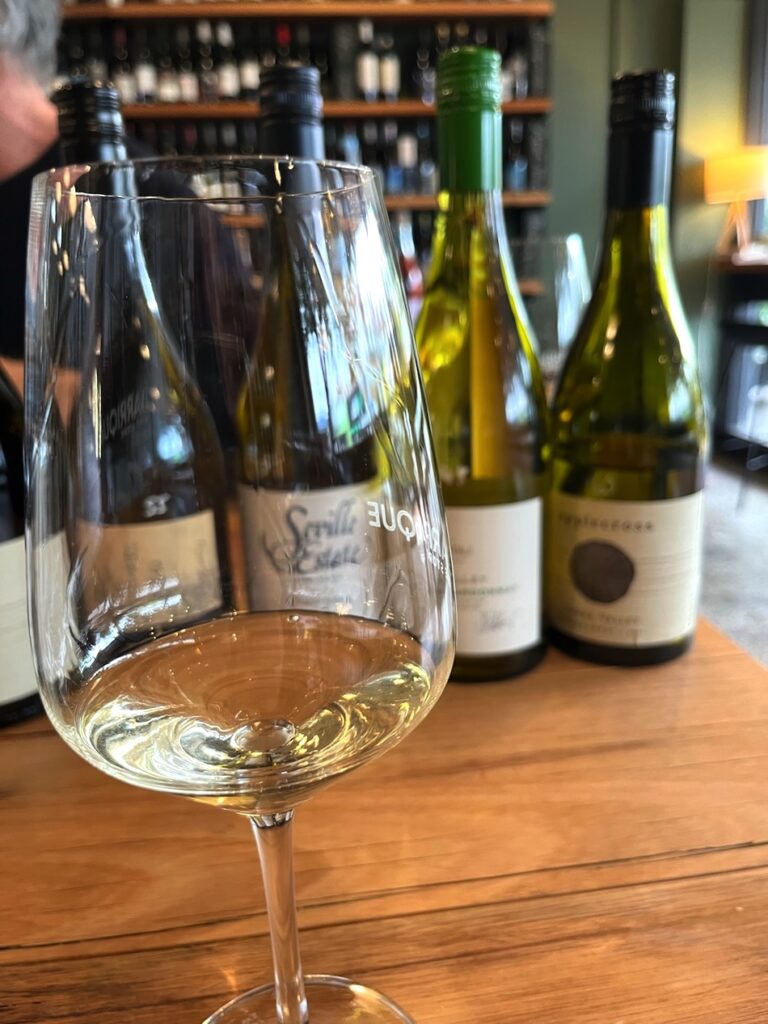
Steve introduces the next wine – and it is one of his… “2021 was a good, long, moderate season I’d say. This is Salo, which is still on red dirt, but down the hill from Applecross by about eighty metres. In that Gladysdale micro-area. Where Dave’s (kiwi Dave McIntosh) is kind of like ‘fermentation – finished – sulphured’, this is allowed to let go right through malo and add some sulphur in late May. So it’s between the Tightness Police and a bit more relaxed. We have a relationship with the grower, and pay him for the hectare of fruit that we take.
Some years that produces four tonnes of fruit – like this year, and some years it produces six or seven. We take on the risk for him and he gives us a pretty good price. The day it is picked you give us the weight, and we’ll pay you. You spent a whole year growing it – here’s your money. Then he can pay his pickers”.
I remind Steve that I was served this Salo Chardonnay in a Wine Bar in Melbourne – Bijou – and I added a photo to my blog as I’ve travelling around, and Lorraine Leheny commented “nice wine” on it. They also offered me a Bloody Hill Shiraz that I had no hesitation in getting as well. Two cracking wines. I was very happy. The Salo Chardonnay has tremendous length, and a lovely creaminess. Fat and generous through the middle, but with that dry finish. The acidity pulls the fruit all the way through to the finish too.
Mike steps in to introduce the third wine in line: “This next wine is the biggest surprise to people – they never pick it blind. They have a picture in their mind of what De Bortoli is going to be, but it is a small, single vineyard wine from a big producer. De Bortoli Section A5 Chardonnay 2019 from Dixon’s Creek”.
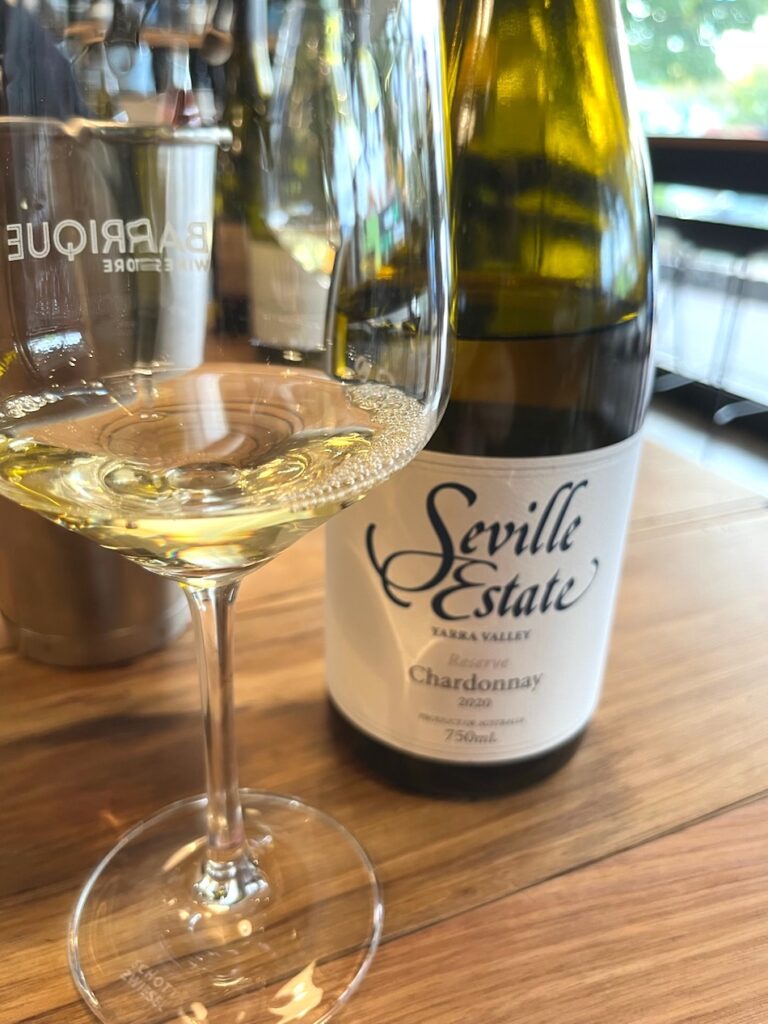
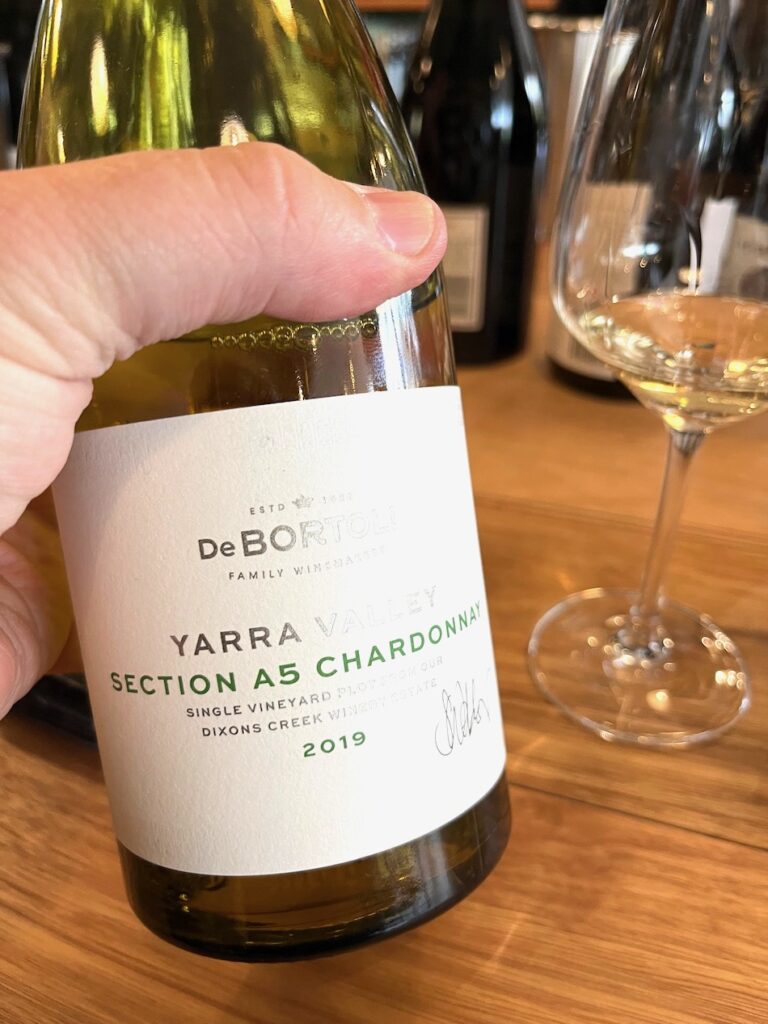
Now, I don’t know what the total figure of De Bortoli’s production is, but it will be a pretty massive figure, so this a great one to have chucked in there. We’ve gone from the cooler southern side of the Upper Yarra over to the northern side which is arguably the major Chardonnay area. I get a nice briney, preserved lemon and green olive note in this one. It’s lost a bit of that piercing drive of acidity that I’ve seen a bit of so far across Victoria, and it’s also quite savoury.
As tastings do… we move quite swiftly, and another Chardonnay is opened. Steve is on the case; “We’ll segue into another, different year. Everyone in ’20 was just like “Pinot has just got ripe” but it took me a year to love the ’20 Chardonnays, and I’ve just come round. Seville Estate vines were planted back in the early ‘70s. Planted Chardonnay before it was trendy. His grandson Dylan is still the winemaker there, which is a nice bit of lineage. It was out in the middle of nowhere really, a little village on the cool, red dirt side of the Valley. This Reserve probably has 35% new oak”.
I want to know what is the difference in soils, from somewhere like De Bortoli to Seville – what does that look like?
Steve: “It goes into the red volcanic-origin soil. Some of them get eroded into ridges, which would be the likes of Wombat Creek and Bastard Hill in the Gladysdale area. Over this side we’re talking about very shallow, eroded clay. Eroded, deposited, eroded, deposited. Very fine soils, good drainage. Soils are different but the standard in Yarra Valley is hand-picked, whole-bunch pressed and wild ferment.
Onto Pinot then – from 2021. We’re going from Upper Yarra for the Applecross Pinot Noir 2021, down to Healesville – just around the corner. High altitude to – I don’t love the expression ‘valley floor’ – so Central Yarra. Both single vineyard and about the same age. Very different winemaker personalities. Both mates of mine and love them both but completely different! Both hand-pick, both a bit of whole bunch, and gentle cap management. No crushing and probably no plunging either.
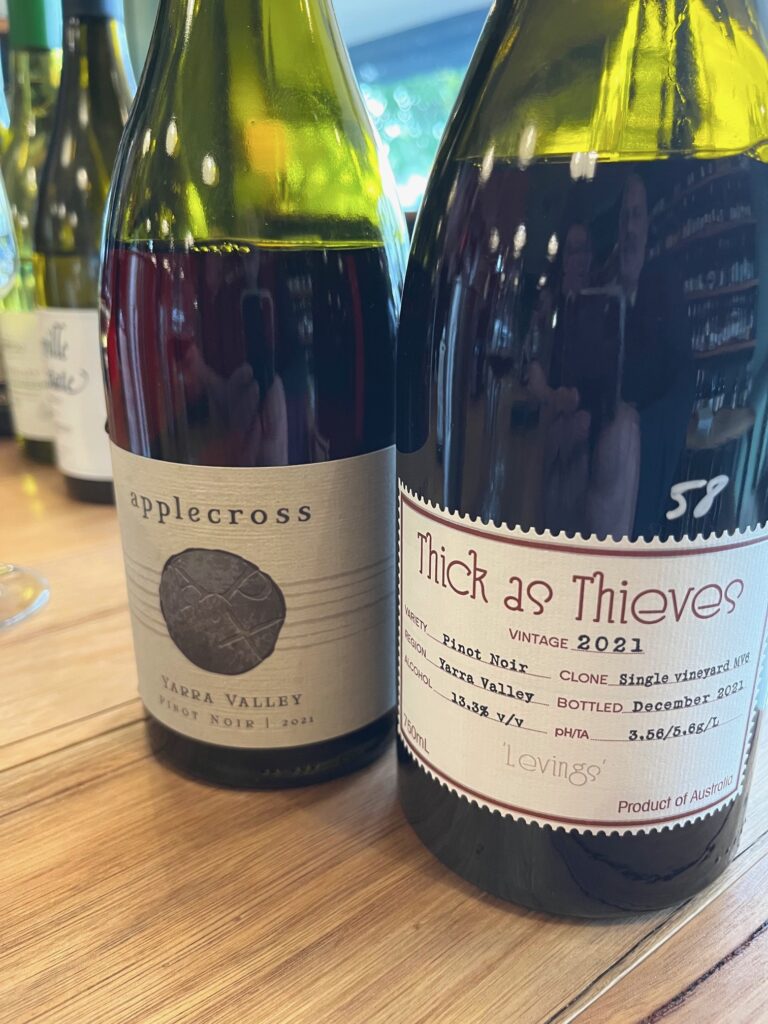
There’s a bit of Abel in the Thick as Thieves Pinot Noir 2021, plus the MV6 clone, which is kind of our 10/5 clone here. New plantings are probably steering a little bit away from it, to newer clones. I love ’21 as a year. I reckon the great years are the ripe years – not too hot or too cold, long seasons”.
My vote is that they’re both delicious, and I would say in that modern style. I’m seeing as many similarities as there are differences in those two wines. I’m seeing both. It’s like a Venn diagram and they meet in the middle. Just that Thick as Thieves has a bit of smoky incense towards the finish. Those two are a great contrast – light and dark – and a way of showing the difference between the two areas. I like cooler seasons generally, and I definitely like some whole bunch – as long as it doesn’t start to mask things, and become the wine. If it is taking over the wine, then it is a flaw. If it is done well it should just sit in there amongst the wine. I wonder if there’s more tolerance for the diverse styles of wines now than there used to be – and ask those around the table.
Steve: “I think people like to be able to point something out that they can see. That’s why people like Marlborough Sauvignon Blanc. It’s like a bright light. And whole bunch – they can smell it in the perfume! I feel like that’s part of it. You can go back to “does it make a wine beautiful?” and yes, if it is in balance. Next up we’ll have another ’21 but also a little baby – a ’22. Thousand Candles Pinot Noir 2021 on the left, which is Stuart Proud – a vigneron who grows the fruit and makes the wine.
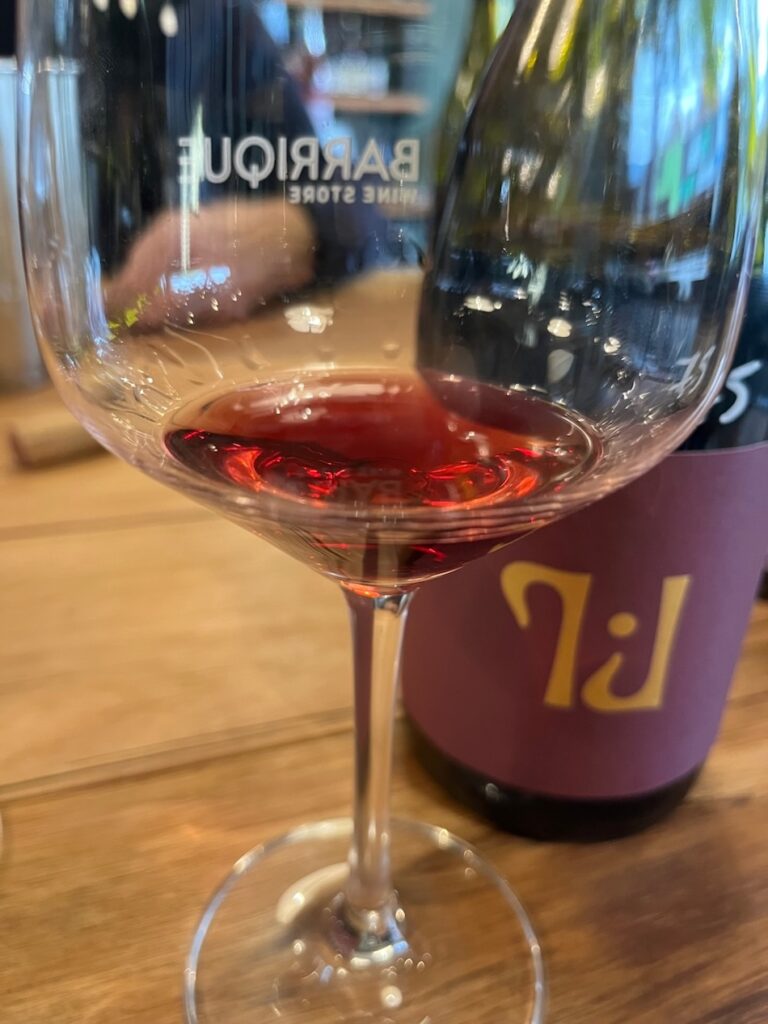
The maker of the Tillie J 2022 still works at Giant Steps, and in the vineyard. Farms her own little plot of Pinot and has done for about five years. She contracts an area – shoot thins it, sprays it, pulls the weeds, does everything on that little block and takes the fruit every year. She makes the Pinot in the corner at Giant Steps – who have always been great with letting me do the Salo project and Tillie do that. Both vineyards for these are up behind Coldstream Hills and for both of them growing the fruit is there main thing, and making the wine is their second focus”.
I reckon there is plenty of savoury character in both of those. The Tillie J one is nice and bunchy, with lots of grip too. And, for a young wine, seems quite resolved already. I hear that Barrique is really valued by the locals – as their local. Both Tillie J and Salo wines sell out very quickly, but the producers will try to make sure that they keep some back for the store, where you’ll see wines you won’t find anywhere else. I tell the boys that I was given a bottle of Gembrook Hill Pinot Noir from Simon Osicka when I was in Heathcote – and meant to open it that night. But I ended up with so many bottles open already on that night, that I’ve brought it with me – back to Yarra!
Steve laughs – “We tried to get that into this tasting but couldn’t get hold of one! It’s my favourite Pinot from Yarra, and I reckon if you asked most winemakers for their favourite two or three, it would usually be in there. When I first came to Yarra in 2001, someone gave me a bottle of Gembrook Hill that night, and I remember thinking “Holy Crap, this is great”.
Now we’re on Syrah. Timo Mayer Syrah 2022 – which shows a plethora of whole bunch, and Seville Estate Shiraz 2021. I hear that many in the area make Syrah the way they made Pinot Noir – as a perfumed red variety. When you put it in South Australia it is big and chunky, but here it is more delicate beast. Timo’s is quite punchy. I’d been up at his winery first thing, and I don’t think he has a destemmer. The Chardonnay goes straight in the press, and the reds go into vats.
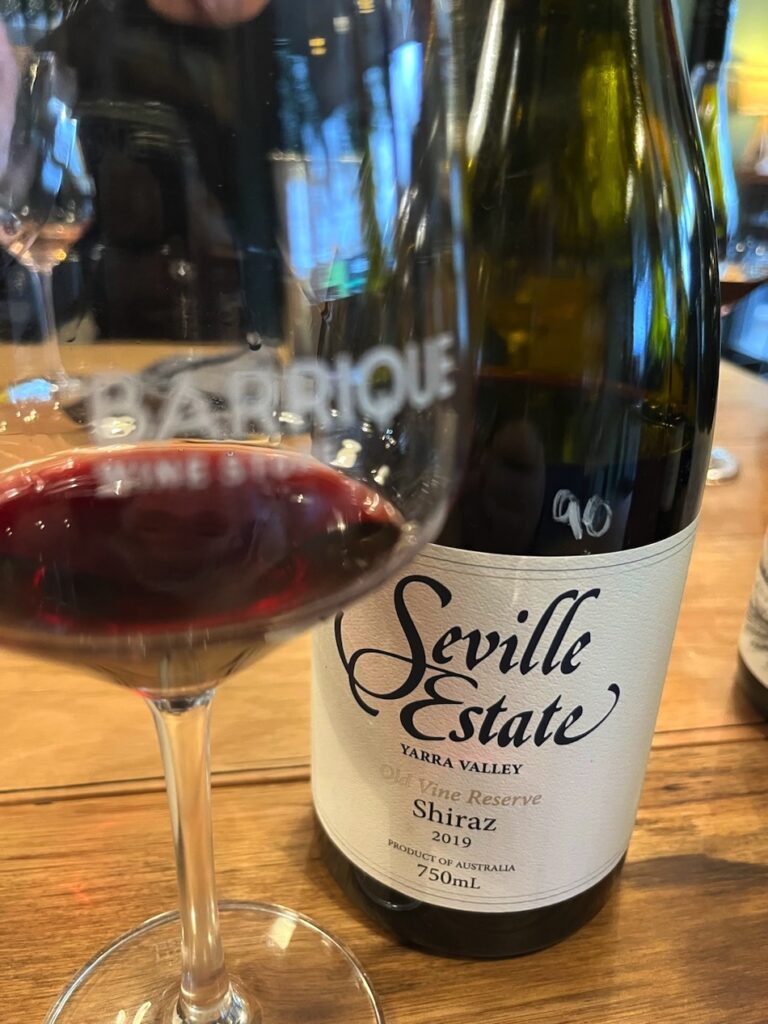
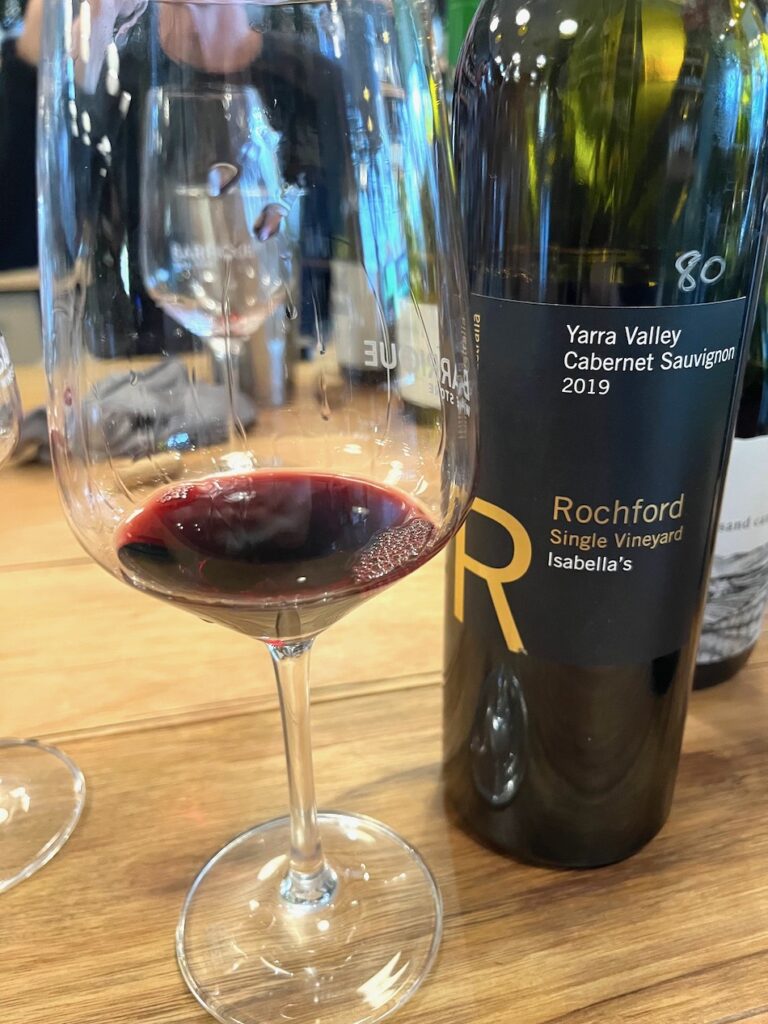
Mike takes his chance to introduce the last wine – obviously a bit of a favourite: “Last red. I chose this because although the Yarra Valley is about Chardonnay and Pinot, I think the best wines here every year are Cabernet. This is Rochford Single Vineyard – Isabella’s 2019”.
Mr Flamsteed adds; “I think it is one of the great sites – next to Sexton. If you know where Coldstream Hills is – this is from that laneway heading up past it. It is a great site – facing due north, getting plenty of sunlight. The vineyard is mature – I don’t know how old? Generally we get to April and we have this long Indian Summer and the Cabernet just sits out there. The winery is under-rated locally, but well-regarded overall”.
I had passed the sign for Rochford on the way to Oakridge. This wine – that’s a Wow for me. It’s a little reductive and tucked away, but you can get a sense of what’s in there. There’s some muscle for sure. Later in the trip I’ll firm up my own ideas on Cabernet Sauvignon in the Yarra Valley – stay poised for that and keep an eye out for many more articles on the site about this region. Thanks to all involved on the day, and for Yarra Valley Winegrowers for giving me this introduction to the area – it proved invaluable as I navigated my way back and forth across the valley for the next three days.

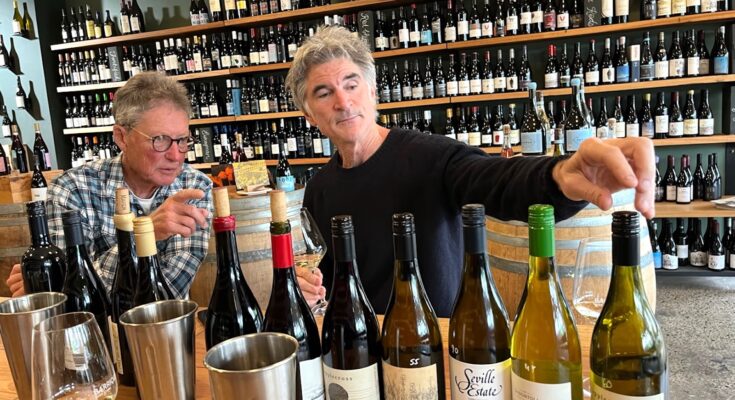
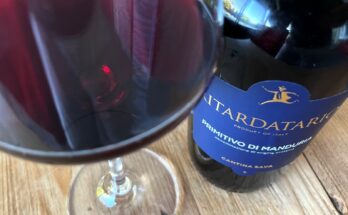
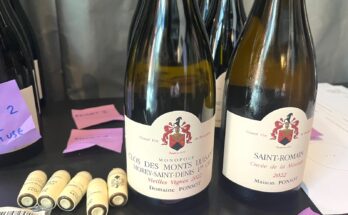
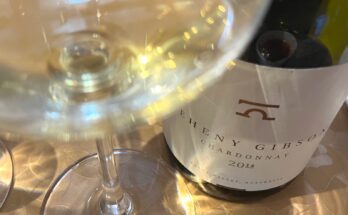
One Comment on “A tasting of Yarra Valley wines – region by region”